Please note, links to all the Freedom Essays are included at the end of this essay. Open any essay to read, print, download, share or listen to (as an audio).
Freedom Essay 22
Fossil discoveries evidence our nurtured origins
This essay, which is drawn from chapter 5:5 of Jeremy Griffith’s book FREEDOM, looks at recent astonishing fossil discoveries, particularly those of the 4.5 million year old Ardipithecus, and how these fossils evidence not only humanity’s cooperative heritage but confirm that it was the love-indoctrination process that made us human.
Artist’s reconstruction of the 4.4 mya Ardipithecus ramidus in its natural habitat
(Painting by paleoartist Jay H. Matternes)
– – – – – – – – – – – – – – – – – –
To recap, in the previous Freedom Essay (F. Essay 21) it was explained that our primate ancestors developed our altruistic, unconditionally selfless, cooperative and loving moral instincts through the nurturing-based, love-indoctrination process. It is explained that while a mother’s maternal instinct to care for her offspring is selfish (as genetic traits normally have to be for them to reproduce and carry on into the next generation), from the infant’s perspective the maternalism has the appearance of being selfless. From the infant’s perspective, it is being treated unconditionally selflessly—the mother is giving her offspring food, warmth, shelter, support and protection for apparently nothing in return. So it follows that if the infant can remain in infancy for an extended period and be treated with a lot of seemingly altruistic love, it will be indoctrinated with that selfless love and grow up to behave accordingly—and over many generations that behaviour will become instinctive because genetic selection will inevitably follow and reinforce any development process occurring in a species; the difficulty was in getting the development of unconditional selflessness to occur in the first place, for once it was regularly occurring it would naturally become instinctive over time. And being semi-upright from living in trees, and thus having their arms free to hold a dependent infant, it was the primates who have been especially facilitated to develop this nurtured, loving, cooperative nature. This is how our primate ancestors developed our moral conscience.
F. Essay 21 also examines how the bonobo variety of chimpanzees, the most cooperative and loving of all non-human primates, evidences the love-indoctrination process—as well as how closely they resemble our early primate ancestor. Included in that essay is the drawing below, which illustrates this similarity.
Left side: Bonobo skeleton. Right side: Early australopithecine.
(Drawing by Adrienne L. Zihlman from New Scientist, 1984)
– – – – – – – – – – – – – – – – – –
Although the fossil record has been slow to yield evidence of our ape ancestors who lived during humanity’s infancy (which lasted from some 12 to 4 million years ago—see chapter 8 of FREEDOM), very recent discoveries of fossils belonging to our direct ancestors from this period are now confirming the love-indoctrination process. These recently unearthed ancestors are: Sahelanthropus tchadensis (who lived some 7 million years ago and is thought to be the first representative of the human line after we diverged from humans’ and chimpanzees’ last common ancestor); Orrorin tugenensis (who lived some 6 million years ago); and Ardipithecus ramidus (who lived some 4.4 million years ago).
Artist’s reconstruction of the 4.4 million year old Ardipithecus ramidus (by Jay H. Matternes).
What a relief to see a portrait of our distant ancestors that doesn’t make
them appear brutish and aggressive, but instead innocent and sensitive!
It is worth emphasising that these fossils have all been found very recently. For example, although fragments of Ardipithecus were first discovered by a team led by the anthropologist Tim White in 1992, and their excavation of a largely intact skeleton (which was nicknamed ‘Ardi’) began in 1994, the remains of the skeleton—1 of only 6 reasonably complete skeletons of early humans older than 1 million years—were in such poor condition that it took until 2009 (over 15 years of analysis) for reports to be published. With studies on all of these recently discovered ancestors now becoming available, including the series of 2009 Ardipithecus reports, which the journal Science deemed ‘Breakthrough of the Year’, it is exciting to see that corroborating evidence of the love-indoctrination process that led to the establishment of our extraordinary unconditionally selfless moral instincts is slowly but surely emerging.
‘Breakthrough of the Year’: cover of the December 2009 issue of Science magazine
So, how does this new evidence confirm the love-indoctrination process? How, for instance, does it affect our understanding of the emergence of bipedalism, the first key factor in developing unconditionally selfless moral instincts?
When Jeremy Griffith first put forward the nurturing, ‘love-indoctrination’ explanation for such instincts in 1983, he said, contrary to prevailing views, that because having arms free to hold a dependent infant was necessary to properly love-indoctrinate an infant, it meant bipedalism must have developed early in this nurturing of love process and, it follows, early in our ancestors’ history—and that is precisely what these fossil discoveries now show. Anthropologists are now reporting that ‘Bipedalism is one of very few human characteristics that appears to have evolved at the base of the hominin clade [species more closely related to modern humans than to any other living species]. Recent fossil discoveries have apparently pushed back the origin of the hominin clade into the late Miocene, to 6 to 7 million years ago (Ma). The oldest known potential hominin [human line] fossils [are] attributed to Sahelanthropus tchadensis’. (See par. 399 of FREEDOM for quote sources.)
Reconstruction of Ardipithecus ramidus showing its bipedality (by Jay H. Matternes)
Fossils of Ardipithecus confirm that bipedalism was well established by 4.4 million years ago, with studies of ‘Ardi’ (the relatively intact skeleton) leading the prominent anthropologist C. Owen Lovejoy to conclude that ‘Ar. ramidus was fully capable of bipedality and had evolved a substantially modified pelvis and foot with which to walk upright’. Furthermore, Lovejoy confirmed the long history of bipedalism that preceded Ar. ramidus when he said that Ar. ramidus ‘has been bipedal for a very long time’. (See par. 401 of FREEDOM for quote sources.)
Along with bipedalism, the second requirement for love-indoctrination to occur is the existence of ideal nursery conditions, namely an environment that provides uninterrupted access to food, shelter and territory. The scientific community’s traditional view has been that the factor in our ancestral history that propelled our ancestor’s development beyond that of the other apes was their movement onto the savannah. However, in light of the fossil evidence that has emerged in the last decade or so (and in the 30 years since Jeremy first proposed the nurturing, love-indoctrination explanation), the scientific community now widely accepts that this separation of our human ancestors from other primates occurred while our ancestors lived in forests and woodlands, where food is plentiful and trees provide shelter and refuge from predators—the specific environment Jeremy identified as being required for the love-indoctrination process to begin.
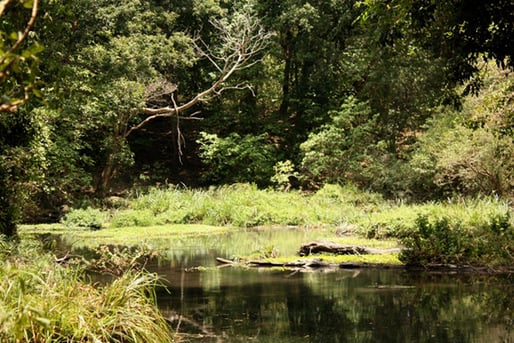
Kibwesi Forest, Kenya – ‘the best modern analog’ for the habitat of
Ardipithecus ramidus (Gibbons 2009, ’Habitat for Humanity’, Science 326:40).
While Sahelanthropus fossils are so limited they don’t provide the information needed to confirm that they were adapted to climbing trees and thus lived in forests or woodlands, reconstructions of their environment have narrowed Sahelanthropus’ habitat to ‘a mosaic of environments from gallery forest at the edge of a lake area to a dominance of large savannah and grassland’. As we move forward in time to Orrorin some 6 million years ago, its skeletal structure shows tree climbing adaptations, which clearly point to them living in an arboreal habitat. Further, associated animal and plant fossils have allowed scientists to infer that ‘Orrorin tugenensis may have evolved in well wooded to forested conditions margining lakes and streams with open country-side in the vicinity’; and that ‘the surroundings of the site were probably open woodland, while the presence of several specimens of colobus monkeys indicate that there were denser stands of trees in the vicinity, possibly fringing the lake margin and streams that drained into the lake’. Forest and woodlands continued to be the preferred habitat of Ar. ramidus some 4.4 million years ago, as indicated by its retention of tree climbing features such as a pelvis that supported large climbing muscles, flexible wrists that allowed walking on all fours along the top of branches, and an opposable big toe that allowed it to grasp the branches with its feet—features that led Tim White to say, ‘Ar. ramidus preferred a woodland-to-forest habitat rather than open grasslands’. In fact, the wealth of surrounding evidence from the Ar. ramidus fossil site in Ethiopia allowed the paleoanthropologist Andrew Hill to remark that ‘There’s so much good data here that people aren’t going to be able to question whether early hominins were living in woodlands’, and fellow researcher Giday WoldeGabriel to state that Ar. ramidus lived ‘in an environment that was humid and cooler than it is today, containing habitats ranging from woodland to forest patches’. Indeed, this ‘good data’ associated with the ‘Ardi’ dig has meant that paleobiologists have been able to reconstruct Ar. ramidus’ habitat to an extraordinary level of detail: ‘Ardi lived on an ancient floodplain covered in sylvan woodlands, climbing among hackberry, fig, and palm trees, and coexisting with monkeys, kudu antelopes, and peafowl’ while ‘doves and parrots flew overhead’. Combine this environment with our knowledge of Ar. ramidus’ diet, which indicates ‘Ar. ramidus was a generalized omnivore and frugivore [fruit eater]’, and our knowledge of existing ape behaviour, which indicates Ar. ramidus ‘almost certainly slept and fed in trees’, and a picture begins to emerge of the ideal nursery conditions that enabled love-indoctrination to develop. (See par. 403 of FREEDOM for quote sources.)
These ideal nursery conditions also refute the long-held nurturing-avoiding theory, espoused by E.O. Wilson amongst others, that upright walking supposedly developed when our ancestors moved out onto the savannah. A member of the ‘Ardi’ team stated that, ‘Ar. ramidus did not live in the open savanna that was once envisioned to be the predominant habitat of the earliest hominids’. In fact, the evidence that bipedality developed in ‘forest or wooded environments’ is now so conclusive that scientists are able to assert that ‘Savannas had nothing to do with upright walking’. Yes, because the development of bipedality is closely associated with the love-indoctrination process it had to have occurred while our ancestors were inhabiting ideal nursery conditions, which clearly suggested an arboreal environment—as Jeremy maintained when he originally put forward the love-indoctrination process in 1983. (See par. 404 of FREEDOM for quote sources.)
These recent fossil discoveries also confirm the third requirement for love-indoctrination to occur: the presence and influence of more maternal mothers. Scientists are able to deduce a remarkable amount of information about the social behaviour of our ancestors from their fossils, and, as a result of this evidence, are now beginning to acknowledge that they exhibited low levels of aggression toward one another, and that females were not only not dominated by males, they actually dictated mate choice by selecting to reproduce with non-aggressive, cooperative males—hallmarks you would expect of a society highly focused on maternal nurturing of their infants. (As is explained in F. Essay 21, the bonobos, our closest living relative, are nurturing, peaceful and matriarchal, in marked contrast to the male-dominated, often violent, common chimpanzees.)
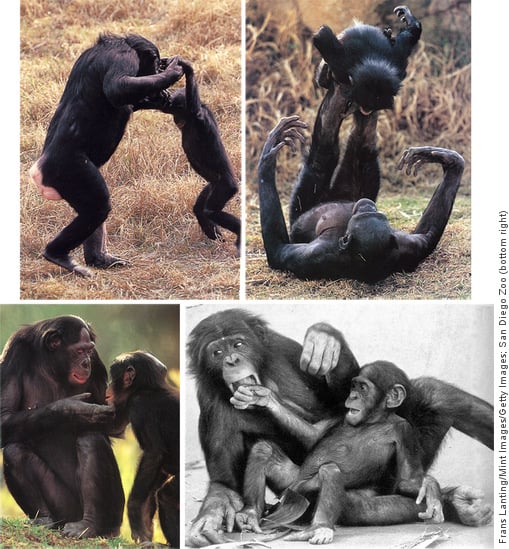
Like that of our early ancestors, bonobos society is matriarchal,
with the focus on the nurturing of infants
The first striking evidence provided by the fossil record to support these deductions is that these early humans had small canine teeth: ‘male canine size and prominence were dramatically reduced by ~ 6 to 4.4 Ma’. This is relevant because ‘canines function as weapons in interindividual aggression in most anthropoid species’, particularly in aggressive male-to-male sexual competition for mating opportunities, and so small canines indicate minimal levels of social aggression. This connection is well established, with primatologists saying, ‘It has long been evident that body and canine size are good indicators of the intensity of male-male competition’. (See par. 406 of FREEDOM for quote sources.)
Human (left), Ardipithecus (middle), male chimpanzee (right)
(‘Paleobiological Implications of the Ardipithecus ramidus Dentition’, Science, 200, Vol. 326, No.5949)
Furthermore, comparisons of canine size in Ar. ramidus with current apes have allowed scientists to extrapolate that Ar. ramidus males ‘retained virtually no anatomical correlates of male-to-male conflict’, a situation that would also apply to our earlier ancestors Sahelanthropus and Orrorin since they too had small canines. Given that the reality of the animal kingdom involves fierce competition between sexually reproducing individuals seeking to reproduce their genes, this reduction in aggressive male competition for mating opportunities is an extremely significant anomaly, as Lovejoy recognises: ‘Loss of the projecting canine raises other vexing questions because this tooth is so fundamental to reproductive success in higher primates. What could cause males to forfeit their ability to aggressively compete with other males?’. A 1992 paper articulated the confusion that has surrounded the evolution of human canine reduction, stating that ‘the issue of human canine evolution has continued to be controversial and apparently intractable’. And the new discoveries have only increased this confusion. But as we can now see, the answer to the ‘vexing’ and ‘apparently intractable’ question of ‘what could cause males to forfeit their ability to aggressively compete with other males’ is the love-indoctrination process.
As will be explained below, conscious sexual or mate selection by females for less competitive, less aggressive, more integrative males developed to assist, speed up and help maintain love-indoctrination’s development of integration. Indeed, male competition for mating opportunities is so ‘fundamental to reproductive success’ that only active sexual selection against it can account for its reduction, as is made clear in this quote: ‘Canine reduction did not result from a relaxation of selection pressure for large canines, but rather a positive selection against them’. Indeed, it has become so apparent that canine reduction could only be caused by ‘a positive selection against them’ that the importance of sexual selection is now being recognised by leading anthropologists such as Lovejoy, Gen Suwa, Berhane Asfaw, Tim White and others, who write, ‘In modern monkeys and apes, the upper canine is important in male agonistic [aggressive] behavior, so its subdued shape in early hominids and Ar. ramidus suggests that sexual selection played a primary role in canine reduction. Thus, fundamental reproductive and social behavioral changes probably occurred in hominids long before they had enlarged brains and began to use stone tools’. (See par. 407 of FREEDOM for quote sources.)
As these authors make clear, the reduction in canine size was such a remarkable achievement that it required ‘fundamental reproductive and social behavioral changes’ in which ‘sexual selection played a primary role’. These scientists are describing a society that switched from being patriarchal—dominated by male sexual selection with males aggressively competing for mating opportunities—to matriarchal, dictated by female sexual selection where females choose mates that are less aggressive. However, what these scientists don’t explain is the only mechanism that could allow such a switch: love-indoctrination. This remarkable reversal where females are empowered, and males ‘forfeit their ability to aggressively compete with other males’, is discussed in more detail in chapter 6 of FREEDOM; however, it is sufficient to emphasise at this point that the fossil record is increasingly providing compelling evidence that female sexual selection was occurring very early in human history, at least as early as Sahelanthropus some 7 million years ago, and that it ‘emerged in concert with habituation to bipedality’ (See par. 408 of FREEDOM), which again is in accord with love-indoctrination, all of which Jeremy first predicted in 1983.
So the three requirements of the love-indoctrination process of bipedality, ideal nursery conditions and selection for more maternal mothers are now being dramatically confirmed by the fossil record. However, as is explained in F. Essay 21, the problem with this nurturing, true explanation is that it has been an unbearably confronting, exposing truth for our present human-condition-afflicted human race that has been so unable to adequately nurture our infants to the extent our instincts expect. As such, this new evidence has left those scientists who continue to deny the importance of nurturing in our development in a predicament in which they are forced to ask the right questions even though they are ‘vexing’, but refuse to acknowledge the truthful answer, because until the human condition was explained nurturing was an off-limits subject. The following passage from Lovejoy exemplifies this predicament: ‘Why did early hominids become the only primate to completely eliminate the sectorial canine complex [large projecting canines that are continuously sharpened against a lower molar]? Why did they become bipedal, a form of locomotion with virtually no measurable mechanical advantage?…These are now among the ultimate questions of human evolution’. Lovejoy further reduced these ‘ultimate questions’ to this one, final sentence that admits the reality of a cooperative past: ‘Even our species-defining cooperative mutualism can now be seen to extend well beyond the deepest Pliocene [well beyond 5.3 million years ago]’.
Yes, the great outstanding mystery for biologists has been how could the cold, selfish, competitive, gene-based natural selection process have possibly created such warm, unconditionally selfless, cooperative, loving instincts in us humans? But to answer that question of questions required the explanation of the human condition that would finally make sense of why we haven’t been able to adequately nurture our infants—because with that compassionate insight it at last becomes psychologically safe to admit that nurturing is what made us human, thus allowing these ‘ultimate questions of human evolution’ to be answered. (See par. 410 of FREEDOM for quote sources.)
– – – – – – – – – – – – – – – – – –
As mentioned at the end of previous F. Essay 21, with the origins of our moral soul now explained and evidenced, the next question begging to be answered is, why did humans become conscious when other animals haven’t? A summary of the answer to this other great question in biology will be presented in two essays’ time in F. Essay 24; and the reason it won’t be in the next essay is because to explain how humans became conscious it’s first necessary to explain that there is an integrative direction, purpose and meaning to existence—the explanation of which will be provided in the next essay, F. Essay 23.
Note that you can also read much more in chapter 5 of FREEDOM about the love-indoctrination process; and see also F. Essay 53 for a wonderful collection of mythological and historical descriptions of our species’ past time of innocence.
Discussion or comment on this essay is welcomed—see below.
Please Note, if you are online you can read, print, download or listen to (as a podcast) THE Interview, The Great Guilt, The Great Transformation, Sermon On The Beach or any of the following Freedom Essays by clicking on them, or you can find them all at www.humancondition.com.
INTRODUCTION TO THE EXPLANATION & RESOLUTION OF THE HUMAN CONDITION: THE Interview That Solves The Human Condition And Saves The World! | The Great Guilt that causes the Deaf Effect | The Great Transformation: How understanding the human condition actually transforms the human race | Sermon On The Beach | Freedom Essay 1 Your block to the most wonderful of all gifts | 2 The false ‘savage instincts’ excuse | 3 THE EXPLANATION of the human condition | 4 The ‘instinct vs intellect’ explanation is obvious – short | 5 The transformation of the human race | 6 Wonderfully illuminating interview | 7 Praise from Prof. Prosen | 8 “How this ends racism forever” | 9 “This is the real liberation of women” | 10 What exactly is the human condition? | 11 The difficulty of reading FREEDOM and the solution | 12 One hour summarising talk | 13 The WTM Deaf Effect Course | 14 Dishonest biology leads to human extinction | 15 How your life can immediately be transformed | 16 The Shock Of Change | THE BOOKS: 17 Commendations & WTM Centres | 18 FREEDOM chapter synopses | 19 FREEDOM’s significance by Prof. Prosen | 20 The genius of Transform Your Life | THE OTHER KEY BIOLOGICAL EXPLANATIONS: 21 How did we humans acquire our altruistic moral conscience? | 22 Fossil discoveries evidence our nurtured origins | 23 Integrative Meaning or ‘God’ | 24 How did consciousness emerge in humans? | 25 The truthful biology of life | • Survey seeking feedback | MEN & WOMEN RECONCILED: 26 Men and women reconciled | 27 Human sex and relationships explained | THE END OF RACISM: 28 The end of racism | 29 Can conflict ever end? | RESIGNATION: 30 Resignation | 31 Wordsworth’s all-revealing great poem | MORE ON THE TRANSFORMATION: 32 More on the Transformation | 33 Jeremy on how to become transformed | THE END OF POLITICS: 34 This understanding ends the polarised world of politics | 35 Death by Dogma left-wing threat | 36 Saving Western civilisation from left-wing dogma | 37 The meaning of superhero and disaster films | RELIGION DECIPHERED: 38 Noah’s Ark explained | 39 Christ explained | 40 Judgment Day finally explained | 41 Science’s scorn of religion | MEANING OF ART & CULTURE: 42 Cave paintings | 43 Ceremonial masks explained | 44 Art makes the invisible visible | • Second survey seeking feedback | 45 Prophetic songs | 46 Anne Frank’s faith in human goodness fulfilled | 47 Humour and swearing explained | 48 R.D. Laing’s fearless honesty | ABOUT BIOLOGIST JEREMY GRIFFITH: 49 Jeremy’s biography | 50 Australia’s role | 51 Sir Laurens van der Post’s fabulous vision | 52 Jeremy’s children’s book A Perfect Life | 53 The ‘instinct vs intellect’ explanation is obvious – long | 54 The accusation of hubris | DO WE FAIL OR DO WE MAKE IT? 55 Endgame for the human race | 56 Why there have been ferocious attacks on the WTM | 57 Magnificence of the Transformed State – video 1 | 58 Magnificence of the Transformed State – video 2 | MARKETING: 59 Shouldn’t the WTM’s website be toned down? | 60 The crime of ‘ships at sea’ ‘pocketing the win’ | GENERAL DISCUSSIONS BY JEREMY: 61 General Discussion by Jeremy Aug. 2018 | 62 Jeremy’s Masterpiece Presentation Feb. 2019 | HEALTH & HEALING: 63 Pseudo therapy/healing | 64 Real therapy/healing | From here on are Transformation Affirmations and More Good Info Emails
These essays were created in 2017-2024 by Jeremy Griffith, Damon Isherwood, Fiona
Cullen-Ward, Brony FitzGerald & Lee Jones of the Sydney WTM Centre. All filming and
editing of the videos was carried out by Sydney WTM members James Press & Tess Watson
during 2017-2024. Other members of the Sydney WTM Centre are responsible for the
distribution and marketing of the videos/essays, and for providing subscriber support.

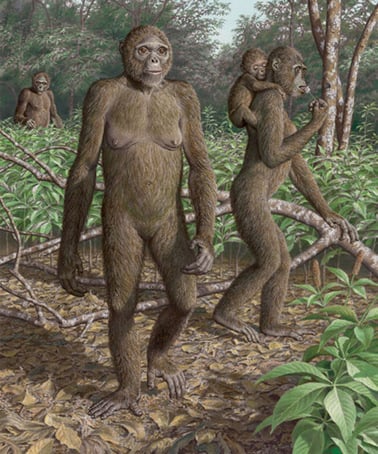
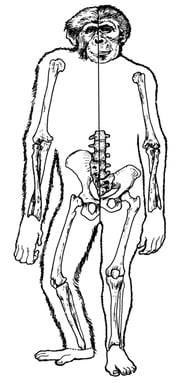
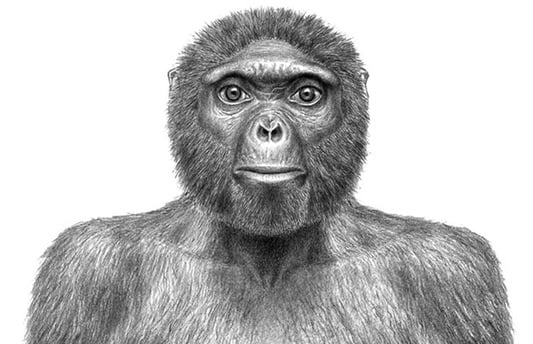
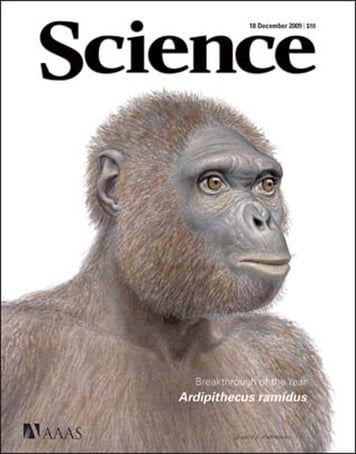
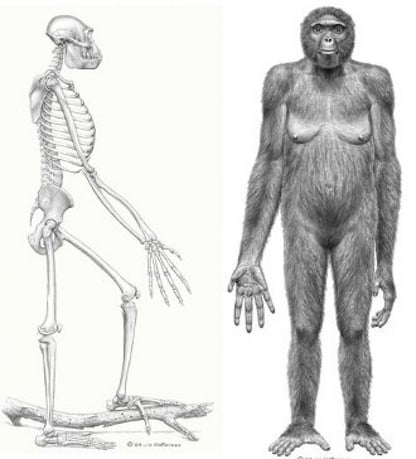
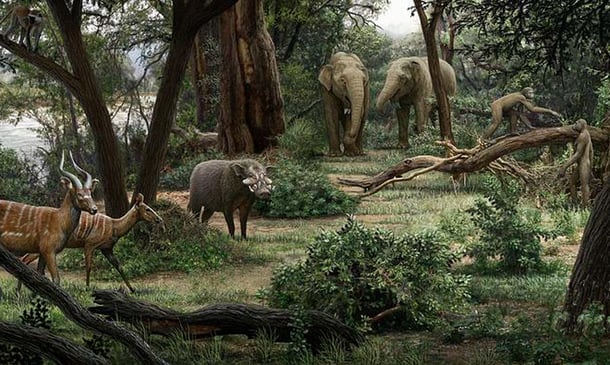

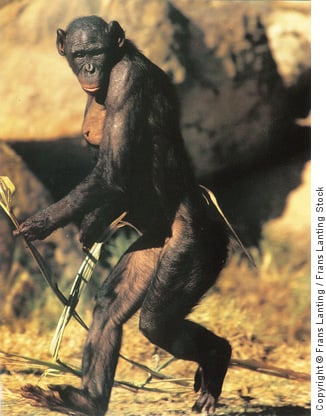
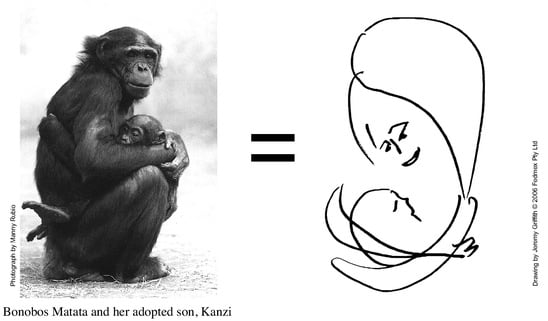
Please wait while the comments load...
Comments